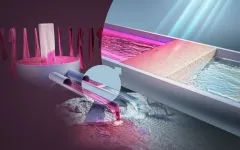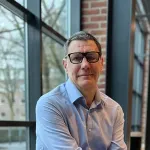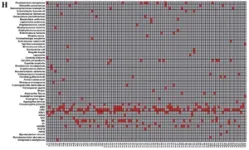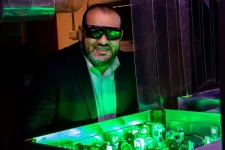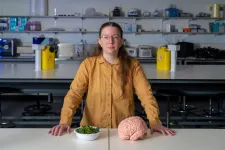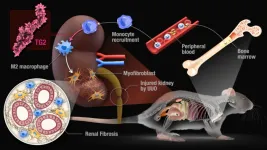(Press-News.org) Researchers at Chalmers University of Technology, Sweden, have developed a new method that can easily purify contaminated water using a cellulose-based material. This discovery could have implications for countries with poor water treatment technologies and combat the widespread problem of toxic dye discharge from the textile industry.
Clean water is a prerequisite for our health and living environment, but far from a given for everyone. According to the World Health Organization, WHO, there are currently over two billion people living with limited or no access to clean water.
This global challenge is at the centre of a research group at Chalmers University of Technology, which has developed a method to easily remove pollutants from water. The group, led by Gunnar Westman, Associate Professor of Organic Chemistry focuses on new uses for cellulose and wood-based products and is part of the Wallenberg Wood Science Center.
The researchers have built up solid knowledge about cellulose nanocrystals* – and this is where the key to water purification lies. These tiny nanoparticles have an outstanding adsorption capacity, which the researchers have now found a way to utilise.
“We have taken a unique holistic approach to these cellulose nanocrystals, examining their properties and potential applications. We have now created a biobased material, a form of cellulose powder with excellent purification properties that we can adapt and modify depending on the types of pollutants to be removed,” says Gunnar Westman.
Absorbs and breaks down toxins
In a study recently published in the scientific journal Industrial & Engineering Chemistry Research, the researchers show how toxic dyes can be filtered out of wastewater using the method and material developed by the group. The research was conducted in collaboration with the Malaviya National Institute of Technology Jaipur in India, where dye pollutants in textile industry wastewater are a widespread problem.
The treatment requires neither pressure nor heat and uses sunlight to catalyse the process. Gunnar Westman likens the method to pouring raspberry juice into a glass with grains of rice, which soak up the juice to make the water transparent again.
“Imagine a simple purification system, like a portable box connected to the sewage pipe. As the contaminated water passes through the cellulose powder filter, the pollutants are absorbed and the sunlight entering the treatment system causes them to break down quickly and efficiently. It is a cost-effective and simple system to set up and use, and we see that it could be of great benefit in countries that currently have poor or non-existent water treatment,” he says.
The method will be tested in India
India is one of the developing countries in Asia with extensive textile production, where large amounts of dyes are released into lakes, rivers and streams every year. The consequences for humans and the environment are serious. Water contaminant contains dyes and heavy metals and can cause skin damage with direct contact and increase the risk of cancer and organ damage when they enter into the food chain. Additionally, nature is affected in several ways, including the impairment of photosynthesis and plant growth.
Conducting field studies in India is an important next step, and the Chalmers researchers are now supporting their Indian colleagues in their efforts to get some of the country's small-scale industries to test the method in reality. So far, laboratory tests with industrial water have shown that more than 80 percent of the dye pollutants are removed with the new method, and Gunnar Westman sees good opportunities to further increase the degree of purification.
“Going from discharging completely untreated water to removing 80 percent of the pollutants is a huge improvement, and means significantly less destruction of nature and harm to humans. In addition, by optimising the pH and treatment time, we see an opportunity to further improve the process so that we can produce both irrigation and drinking water. It would be fantastic if we can help these industries to get a water treatment system that works, so that people in the surrounding area can use the water without risking their health,” he says.
Can be used against other types of pollutants
Gunnar Westman also sees great opportunities to use cellulose nanocrystals for the treatment of other water pollutants than dyes. In a previous study, the research group has shown that pollutants of toxic hexavalent chromium, which is common in wastewater from mining, leather and metal industries, could be successfully removed with a similar type of cellulose-based material. The group is also exploring how the research area can contribute to the purification of antibiotic residues.
“There is great potential to find good water purification opportunities with this material, and in addition to the basic knowledge we have built up at Chalmers, an important key to success is the collective expertise available at the Wallenberg Wood Science Center,” he says.
More about the scientific article
Read the full article in Industrial & Engineering Chemistry Research: Cellulose nanocrystals derived from microcrystalline cellulose for selective removal of Janus Green Azo Dye. The authors of the article are Gunnar Westman and Amit Kumar Sonker of Chalmers University of Technology, and Ruchi Aggarwal, Anjali Kumari Garg, Deepika Saini, and Sumit Kumar Sonkar of Malaviya National Institute of Technology Jaipur in India. The research is funded by the Wallenberg Wood Science Center, WWSC and the Indian group research is funded by Science and Engineering Research Board under Department of Science and Technology (DST-SERB) Government of India.
*Nanocrystals
Nanocrystals are nanoparticles in crystal form that are extremely small: a nanoparticle is between 1 and 100 nanometres in at least one dimension, i.e. along one axis. (one nanometre = one billionth of a metre).
Wallenberg Wood Science Center
• The Wallenberg Wood Science Center, WWSC, is a research centre that aims to develop new sustainable biobased materials using raw materials from the forest. The WWSC is a multidisciplinary collaboration between Chalmers University of Technology, KTH Royal Institute of Technology and Linköping University, and is based on a donation from the Knut and Alice Wallenberg Foundation.
• The centre involves about 95 researchers and faculty members and 50 doctoral students. Eight research groups from Chalmers are part of the centre.
About dye pollutants and access to clean water
• Over two billion people in the world live with limited or no access to clean water. It is estimated that over 3.5 million people die each year from lack of access to clean water and proper sanitation.
• The global textile industry, which is concentrated in Asia, contributes to widespread water pollution. Production often takes place in low-wage countries, where much of the technology is antiquated and environmental legislation and oversight may be lacking.
• Emissions contribute to eutrophication and toxic effects in water and soil. There are examples in China and India where groundwater has been contaminated by dye and processing chemicals.
• Producing one kilogram of new textiles requires between 7,000 and 29,000 litres of water, and between 1.5 and 6.9 kg of chemicals.
• In 2021, around 327 thousand tonnes of dyes and pigments were produced in India. A large proportion of the country's dye pollutants is discharged untreated.
For further information, please contact:
Gunnar Westman, Associate Professor at the Department of Chemistry and Chemical Engineering, Chalmers University of Technology, Sweden.
westman@chalmers.se, +46 31 772 30 72
Sumit Kumar Sonkar, Assistant Professor at the Department of Chemistry, Malaviya National Institute of Technology-Jaipur, India.
sksonkar.chy@mnit.ac.in, +91-9549654857
Captions
Researchers at Chalmers University of Technology, Sweden, have developed a new biobased material, a form of powder based on cellulose nanocrystals to purify water from pollutants, including textile dyes. When the polluted water passes through the filter with cellulose powder, the pollutants are absorbed and the sunlight entering the treatment system causes them to break down quickly and efficiently. Laboratory tests have shown that at least 80 percent of the dye pollutants are removed with the new method and material and the researchers see good opportunities to further increase the degree of purification.
Illustration: Chalmers University of Technology | David Ljungberg
Professor Gunnar Westman, Professor at the Department of Chemistry and Chemical Engineering, Chalmers University of Technology.
Photo: Chalmers University of Technology
Sources
Swedish Environmental Protection Agency: https://www.naturvardsverket.se/amnesomraden/textil/dagens-textila-floden-ar-en-global-miljoutmaning/
WHO: https://www.who.int/news-room/fact-sheets/detail/drinking-water
A critical review on the treatment of dye-containing wastewater: Ecotoxicological and health concerns of textile dyes and possible remediation approaches for environmental safety. Ecotoxicology and Environmental Safety, February 2022
https://www.sciencedirect.com/science/article/pii/S0147651321012720
Effects of textile dyes on health and the environment and bioremediation potential of living organisms. Biotechnology Research and Innovation, July–December 2019
https://www.sciencedirect.com/science/article/pii/S2452072119300413
Swedish Chemicals Agency: https://www.kemi.se/kemiska-amnen-och-material/nanomaterial
Statista: https://www.statista.com/statistics/726947/india-dyes-and-pigments-production-volume/#:~:text=In%20fiscal%20year%202021%2C%20the,around%20327%20thousand%20metric%20tons
END
New wood-based technology removes 80% of dye pollutants in wastewater
2023-03-23
ELSE PRESS RELEASES FROM THIS DATE:
Optical switching at record speeds opens door for ultrafast, light-based electronics and computers
2023-03-23
Imagine a home computer operating 1 million times faster than the most expensive hardware on the market. Now, imagine that level of computing power as the industry standard. University of Arizona researchers hope to pave the way for that reality using light-based optical computing, a marked improvement from the semiconductor-based transistors that currently run the world.
"Semiconductor-based transistors are in all of the electronics that we use today," said Mohammed Hassan, assistant professor of physics and optical sciences. "They're part of every industry – from kids' toys to ...
Depressed, and aging fast
2023-03-23
Older adults with depression are actually aging faster than their peers, UConn Center on Aging researchers report.
“These patients show evidence of accelerated biological aging, and poor physical and brain health,” which are the main drivers of this association, says Breno Diniz, a UConn School of Medicine geriatric psychiatrist and author of the study, which appears in Nature Mental Health on March 22.
Diniz and colleagues from several other institutions looked at 426 people with late-in-life ...
Study finds “considerable uncertainty” around effectiveness and safety of analgesics for low back pain
2023-03-23
Despite nearly 60 years of research, there is still a lack of high certainty evidence on the effectiveness and safety of commonly used painkillers (analgesics) for short bouts of low back pain, finds an analysis of the evidence published by The BMJ.
The researchers say that until higher quality trials comparing analgesics with each other are published, “clinicians and patients are advised to take a cautious approach to manage acute non-specific low back pain with analgesic medicines.”
Analgesics such as paracetamol, ibuprofen, and codeine ...
Ending GP performance pay in Scotland linked to decline in quality of some care
2023-03-23
Ending performance related payments for NHS GPs in Scotland was associated with a decline in the quality of some aspects of care compared with England where financial incentives have continued, finds a study published by The BMJ today.
The researchers say further research is needed to better understand the full impact of withdrawal and the accompanying refocusing of quality improvement resources.
The NHS Quality and Outcomes Framework (QOF) pay-for-performance scheme began in 2004. It was designed to remunerate general practices for providing good quality care across a range of key areas such as cancer, diabetes, heart disease, mental health, and obesity.
In 2016, Scotland abolished ...
CHOP researchers develop first-of-its-kind prediction model for newborn seizures
2023-03-23
Philadelphia, March 22, 2023 – Researchers from the Neuroscience Center at Children’s Hospital of Philadelphia (CHOP) have developed a prediction model that determines which newborn babies are likely to experience seizures in the Neonatal Intensive Care Unit (NICU). This model could be incorporated into routine care to help the clinical team decide which babies will need electroencephalograms (EEGs) and which babies can be safely managed in the Neonatal Care Unit without monitoring through EEGs. This would allow families and providers to care for babies ...
A higher dose of magnesium each day keeps dementia at bay
2023-03-23
More magnesium in our daily diet leads to better brain health as we age, according to scientists from the Neuroimaging and Brain Lab at The Australian National University (ANU).
The researchers say increased intake of magnesium-rich foods such as spinach and nuts could also help reduce the risk of dementia, which is the second leading cause of death in Australia and the seventh biggest killer globally.
The study of more than 6,000 cognitively healthy participants in the United Kingdom aged 40 to 73 found ...
2022 heatwave struck off surgery in fifth of UK hospitals
2023-03-23
The 2022 summer heatwave resulted in a fifth of UK hospitals being forced to cancel operations during the three days when temperatures soared, a new study reveals.
Had the high temperatures continued, a further third of hospitals would have had to cancel surgery, as NHS buildings are not set up to withstand dangerously high temperatures.
The team surveyed surgeons, anaesthetists, and critical care doctors working during the heatwave of 16 – 19 July 2022.
They received 271 responses from 140 UK hospitals with one in five ...
British Ecological Society calls for greater funding for ecological research and sets out research agenda for next 25 years
2023-03-23
Two landmark reports published today (23 March) by the British Ecological Society reveal that ecological sciences are losing out on funding compared to other sciences. The reports also set out a research agenda for ecology over the next 25 years.
With the twin crises of climate change and biodiversity loss, an ecological understanding of the world has never been more pivotal to the future of humanity and all life on Earth.
To further this ecological understanding and highlight the importance of ecology to our future, the British ...
At least 80% of the world’s most important sites for biodiversity on land currently contain human developments, study finds
2023-03-23
PRESS RELEASE FROM THE UNIVERSITY OF CAMBRIDGE
EMBARGOED UNTIL 00.05 LONDON TIME (GMT) ON 23 March 2023
Paper available at: https://drive.google.com/drive/folders/18wVryz17-8PmtYDudp5NPXE75onO12FF?usp=sharing
At least 80% of the world’s most important sites for biodiversity on land currently contain human developments, study finds
At least 80% of sites identified as being internationally important for biodiversity on land currently contain infrastructure − of which more than 75% contain roads.
In the future, more sites that are important for biodiversity could contain powerplants, mines ...
Enzyme-regulating macrophages found in both humans and mice open the door to translating findings in mice into human therapies.
2023-03-23
Researchers at Nagoya University in Japan have identified two enzymes that are involved in macrophage polarization, one of the key factors affecting fibrosis. The group’s findings, reported in Cell Death & Disease, suggest a potential treatment for human patients.
Kidney fibrosis is a dangerous inflammatory disease that causes the organs to stiffen and lose normal function. The disease is linked to a process called macrophage polarization. Polarization is the process by which macrophages, the white blood cells that help the body fight infection and repair tissue, are changed into two types as a response to changes in the microenvironment of the cell: the M1 type, which ...
